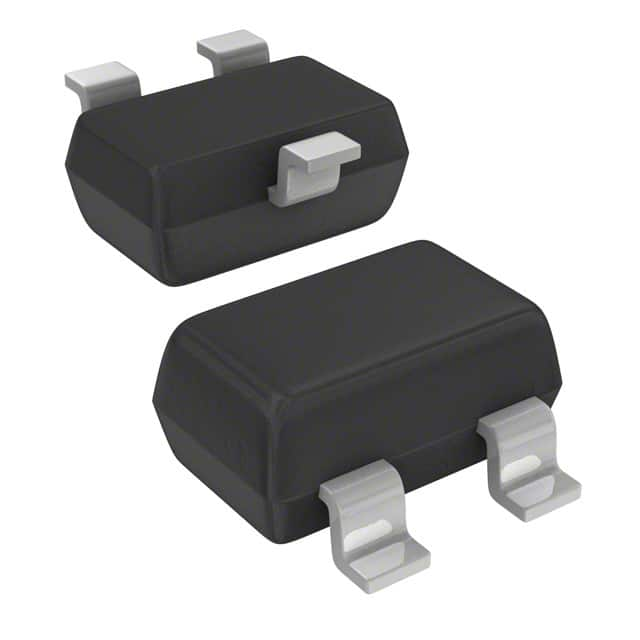Szczegóły produktu można znaleźć w specyfikacjach.

HSMS-280E-TR2G
Introduction
The HSMS-280E-TR2G is a crucial component in the field of electronic devices, specifically within the category of high-frequency Schottky diodes. This entry will provide an overview of its basic information, specifications, detailed pin configuration, functional features, advantages and disadvantages, working principles, detailed application field plans, and alternative models.
Basic Information Overview
- Category: High-frequency Schottky diode
- Use: The HSMS-280E-TR2G is utilized in high-frequency applications such as mixers, detectors, and multipliers due to its low turn-on voltage and fast switching capabilities.
- Characteristics: It exhibits low series resistance, low capacitance, and excellent thermal stability, making it suitable for high-frequency operations.
- Package: The HSMS-280E-TR2G is typically available in a surface-mount SOT-23 package.
- Essence: Its essence lies in providing efficient and reliable high-frequency signal processing.
- Packaging/Quantity: It is commonly supplied in reels with quantities varying based on manufacturer specifications.
Specifications
- Forward Voltage: Typically around 0.3V at 1mA
- Reverse Voltage: Up to 15V
- Capacitance: Approximately 0.6pF at 0V, 1MHz
- Operating Temperature Range: -65°C to +150°C
- Storage Temperature Range: -65°C to +150°C
Detailed Pin Configuration
The HSMS-280E-TR2G follows the standard SOT-23 pin configuration with three pins: anode, cathode, and ground.
Functional Features
- Low Turn-On Voltage: Enables fast switching and efficient signal processing.
- Low Series Resistance: Facilitates minimal power loss during operation.
- Low Capacitance: Ensures minimal signal distortion and high-frequency performance.
Advantages and Disadvantages
Advantages
- Fast switching speed
- Low forward voltage
- Excellent thermal stability
Disadvantages
- Limited reverse voltage tolerance
- Relatively small operating temperature range
Working Principles
The HSMS-280E-TR2G operates based on the Schottky barrier principle, where the metal-semiconductor junction allows for fast electron flow, resulting in its characteristic low forward voltage and fast switching behavior.
Detailed Application Field Plans
The HSMS-280E-TR2G finds extensive use in high-frequency circuits such as: - RF mixers - Signal detectors - Frequency multipliers - High-speed data communication systems
Detailed and Complete Alternative Models
- HSMS-280A-TR1G
- HSMS-282x Series
- HSMS-286x Series
- HSMS-285x Series
In conclusion, the HSMS-280E-TR2G serves as a vital component in high-frequency electronic applications, offering fast switching, low capacitance, and low series resistance. While it has specific limitations, its advantages make it a preferred choice in various high-frequency circuit designs.
Word Count: 410
Wymień 10 typowych pytań i odpowiedzi związanych z zastosowaniem HSMS-280E-TR2G w rozwiązaniach technicznych
What is HSMS-280E-TR2G?
- HSMS-280E-TR2G is a high-speed, low-power Heterogeneous Memory System (HMS) controller designed for use in technical solutions requiring efficient memory management and data processing.
What are the key features of HSMS-280E-TR2G?
- The key features of HSMS-280E-TR2G include support for multiple memory types, low-latency data access, power efficiency, and advanced error correction capabilities.
How does HSMS-280E-TR2G improve system performance?
- HSMS-280E-TR2G improves system performance by optimizing memory access, reducing latency, and providing efficient data transfer between different memory types.
In what technical applications can HSMS-280E-TR2G be used?
- HSMS-280E-TR2G can be used in a wide range of technical applications such as artificial intelligence, machine learning, data analytics, and high-performance computing.
Does HSMS-280E-TR2G support industry-standard interfaces?
- Yes, HSMS-280E-TR2G supports industry-standard interfaces such as DDR, LPDDR, and HBM, making it compatible with a variety of memory technologies.
What are the power requirements for integrating HSMS-280E-TR2G into a system?
- The power requirements for HSMS-280E-TR2G are low, making it suitable for power-constrained environments and portable devices.
Can HSMS-280E-TR2G handle large datasets efficiently?
- Yes, HSMS-280E-TR2G is designed to handle large datasets efficiently, making it well-suited for data-intensive applications.
Are there any specific design considerations when integrating HSMS-280E-TR2G into a technical solution?
- Design considerations when integrating HSMS-280E-TR2G include optimizing memory layout, ensuring proper signal integrity, and managing thermal considerations.
What kind of error correction capabilities does HSMS-280E-TR2G offer?
- HSMS-280E-TR2G offers advanced error correction capabilities such as ECC (Error-Correcting Code) to ensure data integrity and reliability.
Is HSMS-280E-TR2G suitable for real-time processing applications?
- Yes, HSMS-280E-TR2G's low-latency data access and high-speed operation make it suitable for real-time processing applications such as autonomous vehicles and industrial automation.

